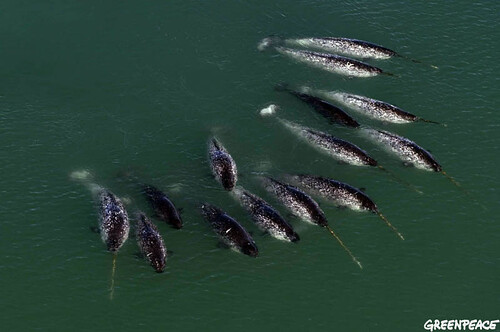Within this species, males are best known for their prominent tusk. This is actually one of its only two teeth, which has been modified to extend straight forward, forming a spiral horn. Females seldom have a tusk and are, therefore, sometimes confused with Beluga Whales. Males use their tusk for aggressive display of strength with other Narwhals, particularly for the benefit of the female Narwhal spectators. For this reason, almost a third of male Narwhals have a broken tusk.

A pair of Narwhal from below.

Pod of Narwhals, monodon monoceros, photographed by Dr Jason Box near Petermann Glacier.
Physical Characteristics
Narwhals have very short beaks with bulbous, proportionally small heads. Their bodies are white or pale grey, with extensive black speckles on the dorsal (or upper) side. As they age, these speckles fade, causing the animal to become lighter and lighter the older they get. The long tusk is spiralled with a white, polished tip.
The Narwhal does not have a dorsal fin, but has a slight hump where this fin may be. Its dorsal flippers are short with distinctly curled up edges. The fluke (tail) is characterised by convex trailing edges and a deep notch in the centre. This shape has been dubbed the “backward-facing tail” for its characteristic shape.
Behaviour
The Narwhal does not spend a lot of time at the surface of the water while it is feeding, but does stay active at the surface when it is migrating. It swims relatively fast during migration, but tends to mill around when hunting. Rest periods can last for up to 10 minutes, during which time the Narwhal will stick close to the surface, perhaps even exposing its dorsal hump.
Narwhals love to spyhop, lobtail and flipper-slap on the surface of the ocean. This provides fabulous displays to human onlookers that are privileged enough to witness them.
They may travel on their own or in groups of up to 25 individuals. Incredibly, pods have been found to include hundreds, even thousands, of individuals at a time. While this is rare, it is a sight that will never be forgotten.
Adults reach between 3.8 and five metres in length (equivalent to around 12.5 to 16.5 feet) and weigh up to 1.6 tonnes.
Where to Find Them
Narwhals live in the Arctic region and are actually recognised for inhabiting one of the most northerly regions of any known cetacean. There are high numbers of Narwhals in the Davis Straight and the Greenland Sea. Their patterns of migration are determined largely by the movement of the ice, which can advance and retreat depending on the weather conditions.
Diet
Narwhals are toothed whales despite the fact that, other than their tusk, they only have one tooth. Therefore, they live on fish, squid and crustaceans that they hunt and capture.
Threats
As human presence continues to spread and the world becomes smaller and smaller due to the increased accessibility of all regions, even these animals are subject to threats from human beings. Hunting and pollution as well as the presence of boats within their natural territory are all major threats to Narwhals.

